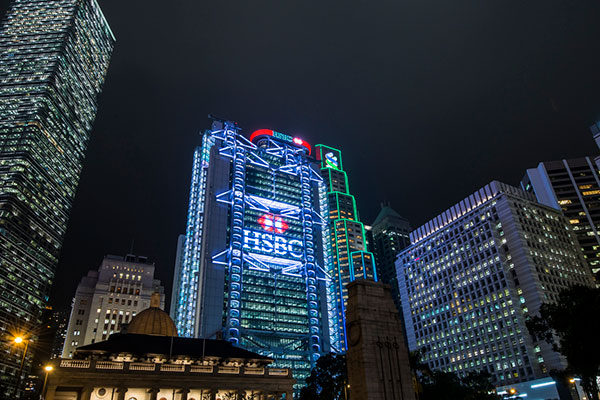Stockwatch: which UK bank shares should be in your ISA?
28th February 2023 11:34
by Edmond Jackson from interactive investor
After years in the doldrums, and with UK bank shares higher in recent months, analyst Edmond Jackson studies prospects and decides which ones he’d have in his ISA.

Just how risky are banks in an ISA portfolio? The question also dials into a current dilemma about what extent you should prioritise “macro” economic narratives, versus news from individual stocks?
For example, the top three London-listed banks – Barclays (LSE:BARC), HSBC Holdings (LSE:HSBA) and Lloyds Banking Group (LSE:LLOY) – have recently reported annual results for 2022. There is quite some variation despite broadly similar operations, with Barclays and HSBC having more by way of volatile investment banking revenues.
- Invest with ii: Open a Stocks & Shares ISA | ISA Investment Ideas | Transfer a Stocks & Shares ISA
Yet long and short-term charts are very similar. There were big de-ratings around the 2008 financial crisis, then a volatile-sideways trend. Recently, there have been gains in the order of 30% since last October lows, although even now it’s still too early to define a breakout.
I believe this shows how bank equities are chiefly affected by the trend in interest rates and the wider economy.
A decade and more of “zero interest rate policy” by central banks compromised lenders’ business models, which are now improving after the return of inflation restored some degree of normality to borrowing costs.
Much depends on whether inflation is contained without causing a serious recession that reduces demand for loans and mortgages, and raises the extent of soured debt.
Bank stocks are thus finely balanced between greed - that a new era of interest rates is under way (especially if inflation never returns to central banks’ 2% target) - and fear that containing prices and incomes will cause a slump. Delayed effects of monetary tightening make this balance tricky, yet China’s reopening after Covid restrictions should help global demand.
- Lloyds Bank dividend up 20% as profits impress
- HSBC boosts dividend as results demonstrate progress
- ii view: room for improvement at Barclays
Whether investors should favour bank equities very much accords with their economic outlook. If you are bearish then wait, but if respecting consensus for a relatively light slowdown, then banks are a long-term opportunity.
For a start, impairment charges already being taken could end up boosting future profits. We saw this in the way insurance companies were able to report bumper profits post-Covid, releasing reserves.
And in line with a key principle for ISA stock selection which I advocated recently, major banks have well-established records of earning power and dividends. Price/earnings (PE) multiples are relatively modest and dividend yields material.
Potentially a ‘Goldilocks’ scenario given a soft landing
Universal bank JPMorgan Chase & Co (NYSE:JPM) is a prime example of how banks can benefit if the global economy muddles through. It’s also worth remembering that stocks listed on any recognised investment exchange can be held in an ISA.
Analysts at Morgan Stanley contend that JPMorgan could more than double in market value to $1 trillion (£835 billion) by 2030 – as it benefits from stronger net interest income, plus improved fees and efficiencies.
Fourth-quarter 2022 numbers showed a 6% rise in net income to over $11 billion, with average loans also up 6% and 2022 as a whole delivering returns on equity and total capital in high teens percentages.
Yet in the near term its CEO Jamie Dimon is cautious: “Today, the economy is wonderful, but in front of us is some scary stuff.” American consumers were flushed with cash during Covid handouts and subsequently a strong labour market.
Already last January he had cited economic slowdown as liable to weigh on net interest income this year, although Dimon quite often sounds cautious as a 66-year-old.
He tells people to prepare for inflation to stick, which counters economists who say it will fall back to 2% - the Bank of England currently expects 4% by the end of this year. I, being a decade younger, broadly agree with him.
Likewise, he warns that progress may be offset by impairment charges on loans and mortgages. It begs a question about sector valuations.
I therefore note Morgan Stanley’s call as exemplifying my intrigue, about how major banks could now enjoy a better decade than the last, hence viewing JPM as a potential ‘buy’. Given JPMorgan’s chart is radically different to UK bank equities – showing US stocks as still relatively over-valued – I would heed its CEO’s caution for now.
Is there value in Barclays as UK’s behavioural bad boy?
Whenever I give Barclays a look over, there always seems some controversy or other. Lately, it has been a £600 million net attributable loss for fines relating to over-issuance of US securities. Lower investment banking profits from equities trading, and corporate advisory and capital-raising were also behind a 15% fall in 2022 net profit to £7.0 billion.
While there is a case to “look through” provisioning to a bank’s underlying earnings, if it has strategically chosen exposure to investment banking, then it arguably implies a modest rating for its diversification. I suggest this is one reason that Barclays trades on a forward PE of just over five times versus Lloyds Banking Group on seven times.
- Should I buy shares in five of the world's biggest banks?
- Where pro fund buyers are investing their ISAs this year
Barclays also has yet to break with a sideways-volatile trend: a 17% fall in earnings per share (EPS) is anticipated this year, then a 12% recovery in 2024. As things stand, a 5.3% prospective yield covered over three times by earnings is fair compensation for near-term risks, assuming they do not materially worsen. If the consensus is right to assume a dividend of 10.4p in respect of 2024, there is scope to lock in a 6.0% yield currently.
Barclays has a strong free cash flow profile, although its dividend record is volatile along with earnings; so again, you are essentially taking a macro view.
Yet at 173p, the stock also trades at a 60% discount to net assets, potentially a margin of safety with which to tuck Barclays away until management gets lucky under improved interest rates. There is a contrarian ‘buy’ case to consider averaging in.

HSBC as a broader play on global economy
Another “universal” bank - one with investment alongside commercial/personal lending activities - its stock enjoyed a 4% advance to 648p in response to 2022 net profit up 15% to $13.9 billion and EPS by 56%. Assuming consensus forecasts, the forward PE is just over seven times.
It offers intrigue for income-seekers, given consensus for a dividend re-rating of over 80% to around 48p equivalent implies a 7.6% yield at a share price of 632p. Earnings cover near 2.0 would, however, be tighter than other banks. At least this optimistic scenario has intrinsic support by way of the stock on 0.9 times net assets, assuming no major write-downs.
HSBC's chief appeal is its historically derived exposure to Asia-Pacific, despite also being the largest bank in Europe. Yet roots in the world’s most dynamic region have not meant HSBC stock avoided the sector’s volatile-sideways’ conundrum.
I recognise a case to hold HSBC as part of modest diversity among bank shares, if unconvinced as to ‘buy’ currently, unless respecting the case for renewed Chinese prosperity.
Lloyds as a domestic play on the UK economy
Its stock is firm at around 52p today after the UK’s agreement with the EU on Northern Ireland – which hopefully opens up a new era of co-operation with Europe after mistrust during Brexit.
This compares with Barclays and HSBC being slightly easier Tuesday, I believe because international investors are likely to see UK risks as mitigating.
But a dilemma remains after reporting 2022 net profit 6% lower at £5.5 billion. If the Bank of England has to turn the monetary screw tighter versus inflation, then not only will UK mortgage lending fall but greater provisioning be required.
- The shares fund managers have held the longest and why
- Stockwatch: five guiding principles for stock selection in an ISA
Lloyds is setting aside £1.5 billion to cover potential loan distress, a year after releasing £1.4 billion provisions as the economy recovered from Covid. This secondary aspect of bank earnings is as much a guess as demand for mortgages/loans.
Shareholders are for now reasonably compensated with a 5.5% prospective yield covered around 2.6 times if consensus earnings estimates are fair. The discount to net assets is slightly better than HSBC, around 0.7 times.
Favouring Barclays as a contrarian ‘buy’
My purpose has been to show how bank equities hinge on economic prospects, but looking past recessionary risks the sector's outlook appears better than the last decade. The market is going to try and price for that, albeit with setbacks along the way.
You could ignore any arguments as to stock selection, and instead take a macro view about how JPMorgan shows London-listed banks as relatively good value for when sentiment turns more definitively.
Edmond Jackson is a freelance contributor and not a direct employee of interactive investor.
Disclosure
We use a combination of fundamental and technical analysis in forming our view as to the valuation and prospects of an investment. Where relevant we have set out those particular matters we think are important in the above article, but further detail can be found here.
Please note that our article on this investment should not be considered to be a regular publication.
Details of all recommendations issued by ii during the previous 12-month period can be found here.
ii adheres to a strict code of conduct. Contributors may hold shares or have other interests in companies included in these portfolios, which could create a conflict of interests. Contributors intending to write about any financial instruments in which they have an interest are required to disclose such interest to ii and in the article itself. ii will at all times consider whether such interest impairs the objectivity of the recommendation.
In addition, individuals involved in the production of investment articles are subject to a personal account dealing restriction, which prevents them from placing a transaction in the specified instrument(s) for a period before and for five working days after such publication. This is to avoid personal interests conflicting with the interests of the recipients of those investment articles.
These articles are provided for information purposes only. Occasionally, an opinion about whether to buy or sell a specific investment may be provided by third parties. The content is not intended to be a personal recommendation to buy or sell any financial instrument or product, or to adopt any investment strategy as it is not provided based on an assessment of your investing knowledge and experience, your financial situation or your investment objectives. The value of your investments, and the income derived from them, may go down as well as up. You may not get back all the money that you invest. The investments referred to in this article may not be suitable for all investors, and if in doubt, an investor should seek advice from a qualified investment adviser.
Full performance can be found on the company or index summary page on the interactive investor website. Simply click on the company's or index name highlighted in the article.
Please remember, investment value can go up or down and you could get back less than you invest. If you’re in any doubt about the suitability of a stocks & shares ISA, you should seek independent financial advice. The tax treatment of this product depends on your individual circumstances and may change in future. If you are uncertain about the tax treatment of the product you should contact HMRC or seek independent tax advice.